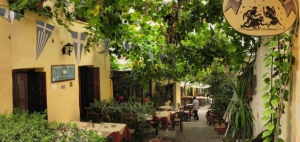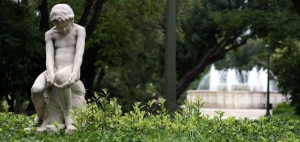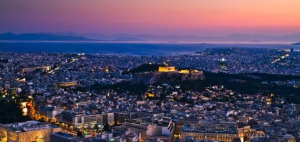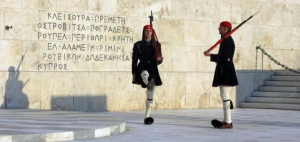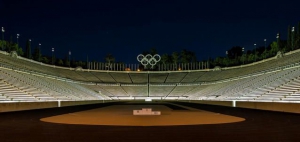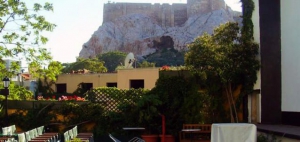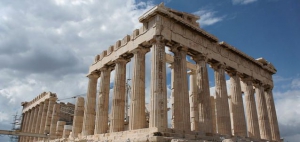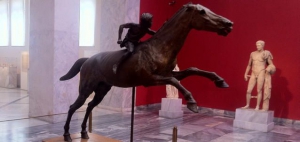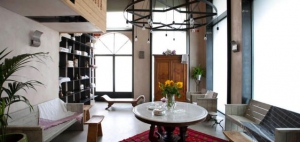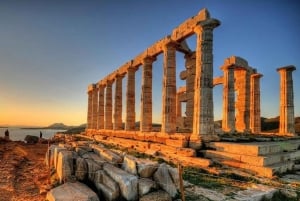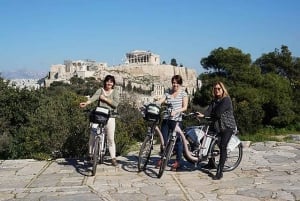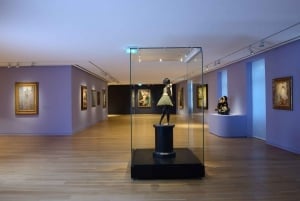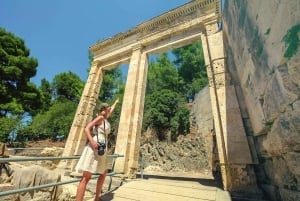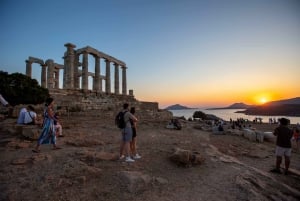10 'Must See' Places in Athens
A holiday spent in is simply the holiday of a lifetime. Athens is the hub of civilisation and the historical centre of Europe with a rich colourful history that stretches back to Ancient times and is fun to uncover at a leisurely pace. The central part of the city is pedestrianised which means tourists on foot can appreciate the best that the city has to offer in their own time. Within this central area, tourists can find some of the most famous archaeological sites, recognised the world over. But there is much more to the city that never sleeps than historical buildings. There are leafy suburbs, colourful markets and great food that can be enjoyed at any hour of the day or night. However, it cannot be disputed that the sheer magic of this wonderful city is most evident when gazing across the rooftops of the city from the Parthenon at sunset. Kalosorisate steen Athena... welcome to Athens....
The Acropolis and The Parthenon
Probably the premier attraction in Europe, the Acropolis is the hill in Athens that commands an excellent view over the city. The hill is dedicated to Athena (goddess of the city) and the name 'Acropolis' comes from the Greek 'acro' meaning 'high' and 'polis' - 'city'. The Acropolis is considered to be sacred and has 21 important monuments and is a UNESCO World Heritage Site, the best and most important monument being the Parthenon.
The Parthenon is a classical Greek style temple that was built at the height of the power of the Athenian empire in 447 BC and is regarded as one of the world's most famous tourist attractions. The Parthenon was made in creamy white marble from Mt Pentelicus which stands about 16 km from the city. The temple was built in Doric style and measures 30.9m x 69.5m. The Parthenon contains many fine sculptures and a famous bas relief frieze. Some of the sculptures were removed from the Parthenon and today some of these are displayed in the Louvre in Paris, others were looted by the Earl of Elgin in 1806 (The Elgin Marbles) and are in the British Museum. Since the 1980's, the Greek Government has been trying to secure the return of the Marbles to Athens. There is a full scale replica of the Parthenon in Nashville Tennessee.
The Greek Parliament
Visiting the Parliament building is popular with visitors as the tomb of the Unknown Soldier is guarded by the Presidential Guards (Evzonas/Tsoliades). The guards are famous for their distinctive white uniforms which include the Foustaneia which is a white pleated skirt with 400 pleats - one for each year that Greece was ruled by Turkey. A great local tip is to get to the Parliament building on the hour, as there is a ceremonial changing of the guard every hour on the hour.
The National Archaeological Museum
Ranked as one of the world's top ten museums. The National Archaeological Museum, which was founded in 1889, traces the country's rich heritage of sculpture, jewellery and pottery through artefacts uncovered by archaeologists in the 19th century. There are more than 11,000 exhibits displayed in its 64 galleries which cover an area of 8,000 square metres and there are five main permanent exhibitions including its prehistoric collection, metallurgy collection and Egyptian and Near East collections.
Amongst its exhibits is the world's first computer! The Antikythera device is 2,000 years old and was found in the shipwreck of the Kythera in 1901. This fascinating analogue computer calculates astronomical positions and is remarkably accurate. The museum also has a sizeable library containing 20,000 volumes on archaeology, Ancient Greek philosophy and Greek and Latin literature. The oldest volumes in the library date from the 17th century.
Panathenaic Stadium (Kalimarmaro)
This beautiful stadium was the setting for the first modern era Olympic Games in 1896. The name Kalimarmaro means 'beautiful marble' and refers to the fact that this is the only stadium in the world that is built entirely of marble. The stadium is a reconstruction of a much older stadium that stood on the site. The first stadium was built there in 328BC and at that stage had wooden seating. It was rebuilt and enlarged in AD140 to accommodate an audience of 50,000 spectators, seated on 50 rows of white marble benches. The stadium was refurbished in 1895 ready for the first international Olympics the following year which drew the largest crowd ever to attend a sporting event. The Olympic Games returned to Athens in 2004.
As well as hosting major sporting events, the stadium is used for important receptions, for example welcoming the triumphant Greek football team home from the Euro football championship with the trophy in 2004. The stadium has also been the setting for a number of musical performances including a concert by Sakis Rouvas on 1 July 2009 when the stadium was filled to capacity for an environmental concert marking the first day of the ban on smoking in public places.
Plaka
Situated on the northern and eastern flanks of the Acropolis is the old part of Athens which has been built on the site of the city's ancient houses. Today the oldest street in the city can be found there - Adrianou Street. Motor vehicles are banned on Adrianou, so it is a great place to wander, relax over a retsina in one of the street bars or enjoy a meal in one of the numerous tavernas or simply pause to watch one of the street entertainers.
There are museums to explore and retail therapy to enjoy with some lovely little shops selling beauty products and foods made from olive oil nestling amongst other selling garish tourist souvenirs. There are regular walking tours available but it is just as much fun to simply wander and there is something of interest around most corners including various craft workshops where iconographers and wood carvers can be watched as they work.
The National Gardens
It is wonderful and refreshing to find such a wonderful leafy oasis in the middle of Athens. The gardens were created in 15 hectares (18 acres) of land in the heart of the city opposite the Parliament buildings in 1840. The gardens were then called the Royal Gardens and were designed by a German specialist, Frederick Schmidt who imported more than 500 species of plants and animals. Today the gardens prove peace and tranquillity from the hustle and bustle and are ideal for a refreshing walk in the leafy shade, for those who prefer, the cafe serves the perfect frappéto enjoy whilst watching the world pass by. There is a duck pond with plenty of ducks and freshwater turtles as well as some ancient ruins to admire. The park is open daily from sunrise - sunset and nothing beats a stroll there as the sun begins to sink behind the horizon.
The Agora (market)
Getting up early is well worth it for the colourful bustle of the Agora, which is the central market off Athineas Street. The stalls are piled high with fruit, vegetables fish and meat, sold by stall holders, many of whom are following in the footsteps of their grandparents. As well as all the stalls there are numerous traders who sit on upturned buckets surrounded by the produce they have gathered earlier that morning!
The fruit stalls are wonderful with the leaves still on the oranges and lemons whilst the fish stalls are piled high with all the different types of fish that can be caught in the Med and beyond. There are stalls selling spices, herbs and more types of olives than you ever imagined! The Feta on sale is the freshest, creamiest possible!
A 'must do' is to eat at one of the little tavernas by the meat market because the food is really authentic! A few words of warning though, the fish soup is going to be the best you have ever tasted but is often served with a whole fish lying in it and I whilst I knew that the meat dish 'podi' was made from cows' feet , I really was not prepared to find the whole hoof on the plate!
The Agora is open Monday - Saturday 07.00-13.00
Mount Lycebettus
Amongst the sprawl of predominately white buildings of Athens, the silhouette of the pine clad mountain of Mt Lycebettus (277 metres - just over 900 feet). The enthusiastic climb to its distinctive twin summits, but the majority hop on the funicular railway in Aristippou Str at Kolonaki. On the summits there is a pleasant cafe to relax and admire the view and the chapel of St George but best of all is the ancient theatre which plays host to a myriad of concerts by Greek and international stars - and what better place to enjoy an outdoor musical feast than with Athens spread out like a sparkly tablecloth below.
Hammam Baths
The perfect way to end a day's sightseeing in the city is at the city's Hammam - traditional Turkish baths. The Hammam are situated in a classical building with its high dome. Inside the baths are modern yet have an authentic character and delicate fragrance of incense to induce relaxation. In years gone by, it was believed that a regular visit to a hammam was good for both physical and mental health as it combats germs and invigorates both the mind and body.
Ciné Paris
Opened nearly 100 years ago, Cine Paris is a wonderful quirky rooftop open air cinema situated just below the floodlights of the Acropolis. There is plenty of film memorabilia from the best known Greek films and whilst many of the films do have Greek dialogue it remains a 'must do' as it is fun to sit out under the stars with the Acropolis as a backdrop. The cinema gets its name from the man who opened it who worked as a barber in Paris. The cinema is open during the summer months only May - September.


